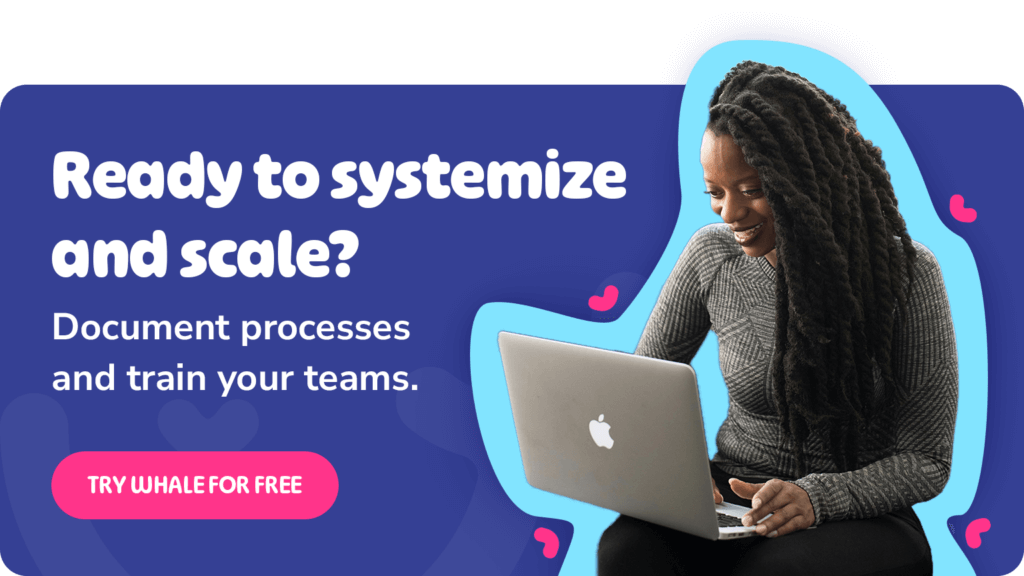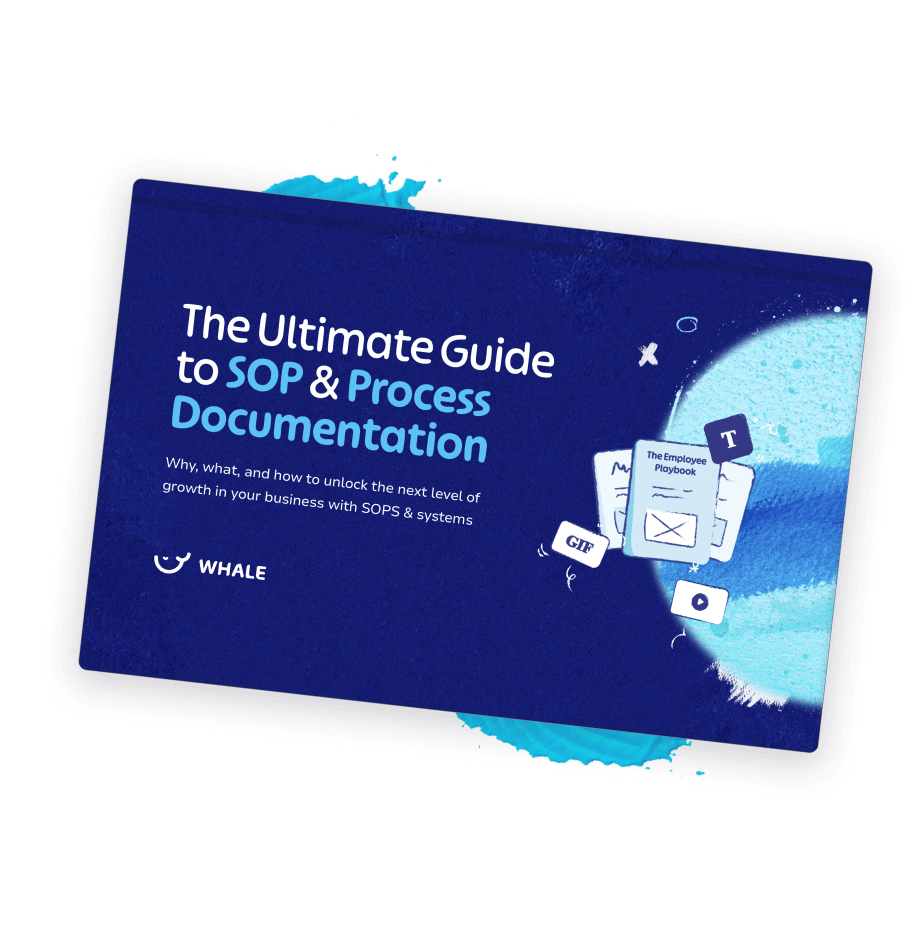How to review your SOPs and company documentation. And why it matters
Why on earth would you need to review your SOPs? 
SOPs are a vital part of your company’s life force and are bound to change along with the company’s growth.
In our piece titled “Why Smart SOPs are the Next Big Win” we stated regular reviews as a key ingredient in creating the ultimate employee experience 
Apart from a great employee experience, keeping your SOPs updated means you’ll be able to unlock growth quicker, ramp-up new team members quicker, and even attract investors.
4 Easy Steps to Review SOPs and Company Documentation
Great but reviewing your processes sounds like a mission?
The good news is that it’s easier than you think!
In fact, by utilizing tools, the review process can become a seamless process. Here are 4 easy steps to review your SOPs:
- Set a review cadence
- Assign responsibility and use the experts
- Check if it’s fit for purpose (Ask WHY?)
- Utilize technology
Review your SOPs Hack #1 - Set a review cadence
How often you review your SOPs and process documentation is going to depend on a number of factors including how often new team members join, how fast the organization is growing and how much use cases change. They may be additional factors to consider such as regulatory changes or new market influences.
For example, if you’ve recently updated your product, this will impact your development team, sales team, marketing, and customer success team. Now imagine that you’ve had two new members join your team just a week after updating the product: one in marketing and one in customer success? And you have to onboard both of them as well as update the rest of the team?
Now you know why it’s so important to review your SOPs.
You may decide you want to review your SOPs and company procedures monthly or you may decide to do it quarterly or even every 6 months to a year. Whatever you choose, as with most habits, consistency is key.
Review your SOPs Hack #2 - Assign ownership and use the experts
It’s a common trait, and mistake, of entrepreneurs to want to do everything but it’s the reason you built a team in the first place. Utilize the subject experts you have available in your team to review and improve your content based on their areas of expertise and ensure a culture of continuous improvement.
Clear ownership means consistency even as people move around the organization.

Review your SOPs Hack #3 - Check if it’s fit for purpose (Ask WHY?)
In a world of complexity, simplicity is created through one simple question:
Why?
Once you know the why, behind your company, you’ll be able to answer the why of SOPs. In the end, we’re trying to create clarity and consistency, not more information.
If your SOP is fit for purpose, your team will want to engage and the information utilized.
Review your SOPs Hack #4 - Utilize technology
Can you see what questions your team has been asking over the last while regarding processes? Do you know what company information was utilized and what wasn’t?
With tools such as Whale 
Once you know what your teams are searching for, you can use the data to spot gaps in your content. For example, if employees keep searching for ‘How to write an SOP,’ you might want to consider creating some assets to help.
Think templates, how-to videos, etc. It doesn’t have to be a long document. Think engagement over length!
Don't stop at reviewing SOPs
Great, you’ve realised that there are a few things that need updating in your SOPs and processes.
But don’t stop there.
Make sure you update the information and get it done.
Do NOT;
- Make post-it notes of what needs to be updated.
- Forget about what needs to be updated.
- Write down on a piece of paper what needs to be updated.
No. Utilize technology like Whale to review and update your SOPs at once. With scheduled reminders to your subject matter experts, SOPs can be reviewed and updated, and approved in just one day.
🔑 Key Tip to Review SOPs
Instead of creating this as a ‘task’ for team members, rather empower them with passion and purpose! When everyone buys into the purpose and vision of the company, they’re far more likely to want to contribute.
How often you review your SOPs and company documentation is going to depend on a number of factors including how often new team members join, how fast the organization is growing and how much use cases change. They may be additional factors to consider such as regulatory changes or new market influences.
For example, if you’ve recently updated your product, this will impact your development team, sales team, marketing, and customer success team. Now imagine that you’ve had two new members join your team just a week after updating the product: one in marketing and one in customer success? And you have to onboard both of them as well as update the rest of the team?
Now you know why it’s so important to review your SOPs.
You may decide you want to review your SOPs and company procedures monthly or you may decide to do it quarterly or even every 6 months to a year. Whatever you choose, as with most habits, consistency is key.

Your SOP review checklist. 🐳 Does your SOP:
- Are you using SOP software? This automates the review process and leaves reviews and updates to the subject experts, making everyone’s lives much easier!
- Reflect the current growth level and status of the company?
- Reflect the purpose, values, and culture of the organization?
- Meet a specific use case and need?
- Help meet a certain organizational objective?
And do your team members love engaging with the content? If your team believes in the mission and loves engaging with the content, they’ll use it!
Mission accomplished! Until the next review!
Bottom line? Reviewing your SOPs are important
Reviewing Standard Operating Procedures (SOPs) is essential for several compelling reasons, ensuring that your operations not only run smoothly but also remain compliant and efficient. Reviewing SOPs can assist your business with;
Compliance and safety: Regulations and industry standards evolve, and regular SOP reviews ensure your operations comply with the latest legal and safety requirements.
Efficiency and Effectiveness: Regular reviews allow you to update SOPs to reflect the most efficient and effective ways of working, eliminating outdated practices and integrating new best practices.
Quality Control: Consistently high-quality outcomes depend on adherence to effective, up-to-date SOPs. Reviews can help identify and correct discrepancies in procedures that might lead to variability in product quality or service delivery.
Employee Training and Performance: New employees rely on SOPs for training and guidance. For existing employees, SOPs serve as a reference to ensure tasks are performed correctly. Updated SOPs help in maintaining a knowledgeable workforce and fostering consistency in performance.
Adaptability: Business environments are dynamic, with changes often occurring in market conditions, customer preferences, and technology. Regular SOP reviews ensure your operations remain agile and can adapt to these changes, maintaining or improving competitiveness.
Continuous Improvement: Regular reviews are part of a culture of continuous improvement, allowing for the refinement of processes and the elimination of inefficiencies. This not only improves operations but also fosters a culture of excellence and innovation.
In essence, reviewing SOPs is not just about maintaining the status quo but actively seeking opportunities to improve, adapt, and lead in your industry.
Ultimately it’s going to give you the highest chance of success in achieving those company rocks and goals.
FAQs about SOP Reviews
How often should SOPs be reviewed?
How often you review your SOPs is dependent on a few factors including;
- Regulatory or legal changes
- Customer and/or team feedback
- Market trends and competition
- Product updates
A common best practice is to review SOPs at least annually although we’d suggest quarterly for all core processes. This can be done in line with a quarterly business review.
PS On Whale, you can assign automatic updates to subject matter experts.
Who should review and update SOPs?
As a founder or VP, you can try to review and update all processes yourself.
But this is NOT valuable use of your time.
You can have one person review the information and another person update the SOP but generally it’s easier to keep this to one person.
Instead assign SOP reviews on a set schedule or frequency to subject matter experts.
You could even get external consultants to help you review and update your SOPs and company documentation.
Questions to ask when updating and reviewing SOPs?
How do you know what you should be updating in your SOP?
Here are a few questions to ask yourself to know what to update;
- Is the scope still relevant?
- Is the SOP still needed in the business?
- Has the process changed?
- Is there a way to do things better?
- What is the impact and ROI of the SOPs?
Key Terms & Further Reading on SOPs Reviews
Related blog posts
Ultimate Guide to SOP & Process Documentation
The why, what, and how to unlock the next level of growth in your business with SOPS & systems
What is your greatest challenge?
SOP & Process Documentation
Use Whale to create SOP & Process Documentation and centralize everything in an easily accessible single source of truth.
Employee Onboarding & Training
Whale is the fastest way to get your team aligned. Discover how Whale boosts team performance and ensures new hires excel from the get-go.
Companies on EOS ®
Whale is the all-in-one system for teams running on EOS® to help document your processes, train your teams, and build a foundation for growth.









